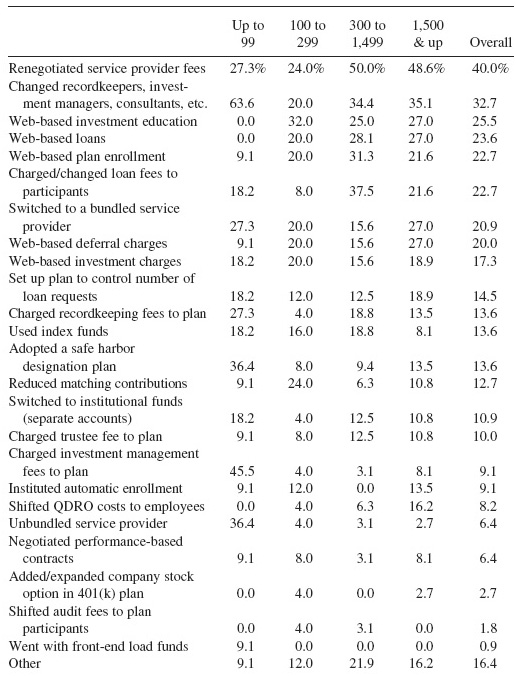Chapter 5
401(k) Plan Costs
CONTROLLING 401(K) PLAN COSTS
To control plan costs, 401(k) managers are still taking an active role in monitoring service providers. Rather than changing providers, though, as they tended to do last year, 401(k) plan managers’ favorite approach is to keep their existing providers and renegotiate fees with them. A sizable 40% of the survey respondents listed renegotiating service provider fees as their most successful 401(k) cost-control technique (see Exhibit 5.1), according to an IOMA survey. This was up from the 32.8% who cited it the prior year.
Exhibit 5.1 Categories in which 401(k) Plan Sponsors Have Had the Most Success in Controlling 401(k) Plan Costs during the Past Two Years, by Number of Participants

As the plan administrator at a nonprofit firm told us, “High participation rates plus high contribution levels lead to high plan balances and high average account balances.” That, in turn, allowed this 520-employee firm in New York to negotiate lower fees with its service providers.
“We were able to negotiate lower fees and revenue sharing arrangements with our third-party administrator and vendors,” added a large government entity from Texas. “When we renew contracts, we do industry comparisons and either renegotiate it or send out a request for proposal. Revenue shares [i.e., for 12-b1 fees, which some fund companies levy to pay for marketing, ...
Get Cost Reduction and Control Best Practices: The Best Ways for a Financial Manager to Save Money, 2nd Edition now with the O’Reilly learning platform.
O’Reilly members experience books, live events, courses curated by job role, and more from O’Reilly and nearly 200 top publishers.

